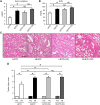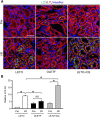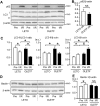Suppressed autophagic response underlies augmentation of renal ischemia/reperfusion injury by type 2 diabetes
- PMID: 28706237
- PMCID: PMC5509657
- DOI: 10.1038/s41598-017-05667-5
Suppressed autophagic response underlies augmentation of renal ischemia/reperfusion injury by type 2 diabetes
Abstract
Diabetes mellitus is a major risk factor for acute kidney injury (AKI). Here, we hypothesized that suppression of autophagic response underlies aggravation of renal ischemia/reperfusion (I/R) injury by type 2 diabetes mellitus (T2DM). In OLETF, a rat model of T2DM, and its non-diabetic control, LETO, AKI was induced by unilateral nephrectomy and 30-min occlusion and 24-h reperfusion of the renal artery in the contralateral kidney. Levels of serum creatinine and blood urea nitrogen and tubular injury score after I/R were significantly higher in OLETF than in LETO. Administration of chloroquine, a widely used autophagy inhibitor, aggravated I/R-induced renal injury in LETO, but not in OLETF. In contrast to LETO, OLETF exhibited no increase in autophagosomes in the proximal tubules after I/R. Immunoblotting showed that I/R activated the AMPK/ULK1 pathway in LETO but not in OLETF, and mTORC1 activation after I/R was enhanced in OLETF. Treatment of OLETF with rapamycin, an mTORC1 inhibitor, partially restored autophagic activation in response to I/R and significantly attenuated I/R-induced renal injury. Collectively, these findings indicate that suppressed autophagic activation in proximal tubules by impaired AMPK/ULK1 signaling and upregulated mTORC1 activation underlies T2DM-induced worsening of renal I/R injury.
Conflict of interest statement
The authors declare that they have no competing interests.
Figures







Similar articles
-
Autophagy activation attenuates renal ischemia-reperfusion injury in rats.Exp Biol Med (Maywood). 2015 Dec;240(12):1590-8. doi: 10.1177/1535370215581306. Epub 2015 Apr 21. Exp Biol Med (Maywood). 2015. PMID: 25898836 Free PMC article.
-
Inhibition of DPP-4 reduces acute mortality after myocardial infarction with restoration of autophagic response in type 2 diabetic rats.Cardiovasc Diabetol. 2015 Aug 11;14:103. doi: 10.1186/s12933-015-0264-6. Cardiovasc Diabetol. 2015. PMID: 26259714 Free PMC article.
-
Aged kidneys are refractory to autophagy activation in a rat model of renal ischemia-reperfusion injury.Clin Interv Aging. 2019 Mar 1;14:525-534. doi: 10.2147/CIA.S197444. eCollection 2019. Clin Interv Aging. 2019. PMID: 30880933 Free PMC article.
-
Rapamycin induces autophagy to alleviate acute kidney injury following cerebral ischemia and reperfusion via the mTORC1/ATG13/ULK1 signaling pathway.Mol Med Rep. 2018 Dec;18(6):5445-5454. doi: 10.3892/mmr.2018.9586. Epub 2018 Oct 24. Mol Med Rep. 2018. PMID: 30365078 Free PMC article.
-
NGAL attenuates renal ischemia/reperfusion injury through autophagy activation and apoptosis inhibition in rats.Chem Biol Interact. 2018 Jun 1;289:40-46. doi: 10.1016/j.cbi.2018.04.018. Epub 2018 Apr 25. Chem Biol Interact. 2018. PMID: 29704511
Cited by
-
Diabetes induces hepatocyte pyroptosis by promoting oxidative stress-mediated NLRP3 inflammasome activation during liver ischaemia and reperfusion injury.Ann Transl Med. 2020 Jun;8(12):739. doi: 10.21037/atm-20-1839. Ann Transl Med. 2020. PMID: 32647664 Free PMC article.
-
Kidney Proximal Tubule GLUT2-More than Meets the Eye.Cells. 2022 Dec 26;12(1):94. doi: 10.3390/cells12010094. Cells. 2022. PMID: 36611887 Free PMC article. Review.
-
Enhanced renal ischemia-reperfusion injury in aging and diabetes.Am J Physiol Renal Physiol. 2018 Dec 1;315(6):F1843-F1854. doi: 10.1152/ajprenal.00184.2018. Epub 2018 Sep 12. Am J Physiol Renal Physiol. 2018. PMID: 30207168 Free PMC article.
-
Protective effect of hydroxysafflor yellow A against acute kidney injury via the TLR4/NF-κB signaling pathway.Sci Rep. 2018 Jun 15;8(1):9173. doi: 10.1038/s41598-018-27217-3. Sci Rep. 2018. PMID: 29907783 Free PMC article.
-
Liraglutide Ameliorates Erectile Dysfunction via Regulating Oxidative Stress, the RhoA/ROCK Pathway and Autophagy in Diabetes Mellitus.Front Pharmacol. 2020 Aug 12;11:1257. doi: 10.3389/fphar.2020.01257. eCollection 2020. Front Pharmacol. 2020. PMID: 32903510 Free PMC article.
References
Publication types
MeSH terms
Substances
LinkOut - more resources
Full Text Sources
Other Literature Sources
Medical

